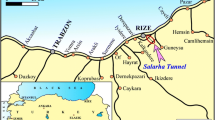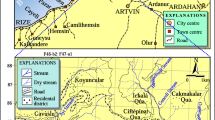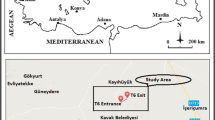Abstract
The paper reports an assessment of the engineering geological characteristics of the rock mass to be encountered between Mecidiye and Gazino stations on the new extension of the Ankara metro and the determination of appropriate support and excavation methods. The rock mass quality was estimated using the rock mass rating (RMR), geological strength index (GSI) and rock mass quality (Q) systems and the tunnel divided into sections. The RMR, Q and NATM systems were used to determine the support and excavation methods in these areas. The deformations and stress concentrations around each tunnel section were investigated and the interaction of the support systems with the rock mass was analyzed using finite element software. It is concluded that rock mass classification systems should be used in tandem with numerical tools, although it is emphasized that the estimation of rock mass properties is not an exact science and both rock properties and numerical models should be refined based on observations and the results of instrumentation installed during the construction of a tunnel.
Résumé
L’article présente une évaluation des caractéristiques géotechniques des massifs rocheux devant être rencontrés entre les stations de Mecidiye et Gazino pour la nouvelle extension du métro d’Ankara, ainsi que la définition des soutènements appropriés et des méthodes d’excavation. La qualité des massifs rocheux a été estimée à partir de la méthode rock mass rating (RMR), la méthode geological strength index (GSI) et l’indice qualité Q (Q system), le tunnel étant divisé en plusieurs sections. Les méthodes RMR, Q système et NATM ont été utilisées pour définir les soutènements et méthodes d’excavation adaptées aux différentes sections. Les déformations et concentrations de contraintes relatives à chaque section de tunnel ont été étudiées et les interactions entre les dispositifs de soutènement et les massifs rocheux ont été analysées avec un logiciel aux éléments finis. L’article conclut que les méthodes de classification des massifs rocheux devraient être utilisées conjointement avec les outils numériques, bien que qu’il soit souligné que l’estimation des propriétés des massifs rocheux n’est pas une science exacte. A la fois la détermination des propriétés des massifs rocheux et les modèles numériques devraient être affinés sur la base d’observations et des mesures issues des dispositifs de surveillance installés pendant la construction d’un tunnel.








Similar content being viewed by others
References
Aydan O, Dalgic S (1998) Prediction of deformation behaviour of 3-lanes Bolu tunnels through squeezing rocks of North Anatolian fault zone (NAFZ). In: Proceedings of the regional symposium on sedimentary rock engineering, Taipei, Taiwan, pp 228–233
Barton N (2000) TBM tunnelling in jointed and faulted rock. Balkema, Rotterdam, 169 p
Barton N (2002) Some new Q-value correlations to assist in site characterization and tunnel design. Int J Rock Mech Min Sci 39(1):185–216
Barton NR, Lien R, Lunde J (1974) Engineering classification of rock masses for the design of tunnel support. Rock Mech 4:189–239
Basarir H (2006) Engineering geological studies and tunnel support design at Sulakyurt dam site, Turkey. Eng Geol 86(4):225–237
Basarir H (2008) Analysis of rock-support interaction using numerical and multiple regression modeling. Can Geotech J 45:1–13
Basarir H, Ozsan A, Karakus M (2005) Analysis of support requirements for a shallow diversion tunnel at Guledar dam site, Turkey. Eng Geol 81(2):131–145
Bhasin R, Grimstad E (1996) The use of stress–strength relationships in the assessment of tunnel stability. Tunn Undergr Space Technol 11(1):93–98
Bieniawski ZT (1978) Determining rock mass deformability: experience from case histories. Int J Rock Mech Min Sci Geomech Abstr 15:237–247
Bieniawski ZT (1989) Engineering rock mass classifications. Wiley, New York
Cai M, Kaiser PK, Tasaka Y, Minami M (2007) Determination of residual strength parameters of jointed rock masses using the GSI system. Int J Rock Mech Min Sci 44(2):247–265
Goel RK, Jethwa JL, Paithankar AG (1995) Indian experiences with Q and RMR systems. Tunn Undergr Space Technol 10(1):97–109
Grimstad E, Barton N (1993) Updating the Q-system for NMT. In: Proceedings of the international symposium on sprayed concrete, fagernes, Norway, Norwegian concrete association, Oslo, Norway, pp 20
Hoek E (2007) Practical rock engineering. http://www.rocscience.com
Hoek E, Brown ET (1980) Underground excavations in rock. Institution of Mining and Metallurgy, Elsevier, London, 527 p
Hoek E, Brown ET (1998) Practical estimates of rock mass strength. Int J Rock Mech Min Sci 34(8):1165–1186
Hoek E, Kaiser PK, Bawden WF (1995) Support of underground excavations in hard rock. Balkema, Rotterdam, 215 p
Hoek E, Carranza-Torres C, Corkum B (2002) Hoek-Brown failure criterion—2002 edition. In: Hammah R, Bawden W, Curran J, Telesnicki M (eds) Proceedings of NARMS-TAC 2002, mining innovation and technology. Toronto, Canada, pp 267–273
ISRM (1981) Rock characterizition, testing and monitoring. In: Brown ET (ed) ISRM suggested methods. Pergamon Press, New York, p 211
Kalamaris GS, Bieniawski ZT (1995) A rock mass strength concept for coal incorporating the effect of time. In: Proceedings of the eighth international congress on rock mechanics, vol 1, Melbourne, Australia, pp 295–302
Karakus M, Ozsan A, Basarir H (2007) Finite element analysis for the twin metro tunnel constructed in Ankara clay, Turkey. Bull Eng Geol Environ 66:71–79
Kontogianni VA, Stiros SC (2002) Predictions and observations of convergence in shallow tunnels: case histories in Greece. Eng Geol 63:333–345
Mitri HS, Edrissi R, Henning J (1994) Finite element modeling of cable-bolted slopes in hard rock underground mines. SME annual meeting, SME, Albuquerque, New Mexico, USA, pp 94–116
Ordemir I, Alyanak I, Birand AA (1965) Report on Ankara clay. METU Publication 12, Ankara, Turkey
Ordemir I, Soydemir C, Birand AA (1977) Swelling problems of Ankara clays. In: Proceedings of the 9th international conference on soil mechanics and foundation engineering, vol 1, Tokyo, Japan, pp 243–247
Özsan A, Karpuz C (2001) Preliminary support design for Ankara subway extension tunnel. Eng Geol 59(1–2):161–172
Ramamurthy T (1986) Stability of rock masses. Indian Geomech J 16(1):1–74
Read SAL, Richards LR, Perrin ND (1999) Applicability of the Hoek-Brown failure criterion to New Zealand greywacke rocks. In: Proceedings of the ninth international society for rock mechanics congress, Paris, France, vol 2, pp 655–660
Rocscience (2001) Phase2 user’s guide. Rocscience, Toronto
Russo G, Kalamaras GS, Grasso PA (1998) Discussion on the concepts of geomechanical classes behavior categories and technical classes for an underground project. Gallerie e Grandi Opere Sotterranee 1998; 54
Sari D, Pasamehmetoglu AG (2004) Proposed support design, Kaletepe tunnel, Turkey. Eng Geol 72:201–216
Sheorey PR (1997) Empirical rock failure criteria. Balkema, Rotterdam
Trueman R (1988) An evaluation of strata support techniques in dual life gateroads. PhD Thesis, University of Wales, Cardiff
Turkish Ministry of Public Works and Settlement (1996) Evaluation of earthquake regions by geographical information systems. Turkish Ministry of Public Works and Settlement, Ankara (in Turkish), 65 pp
Acknowledgments
The authors would like to express their gratitude to the Greater Municipality of Ankara, General Directorate of EGO managers for their kind assistance throughout the project.
Author information
Authors and Affiliations
Corresponding author
Rights and permissions
About this article
Cite this article
Özsan, A., Başarır, H., Yüceel, S. et al. Engineering geological evaluation and preliminary support design for the metro extension tunnel, Ankara, Turkey. Bull Eng Geol Environ 68, 397–408 (2009). https://doi.org/10.1007/s10064-009-0192-3
Received:
Accepted:
Published:
Issue Date:
DOI: https://doi.org/10.1007/s10064-009-0192-3




